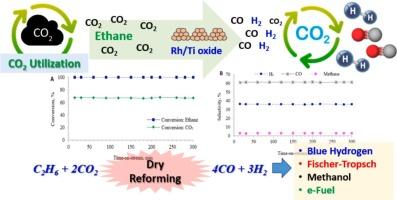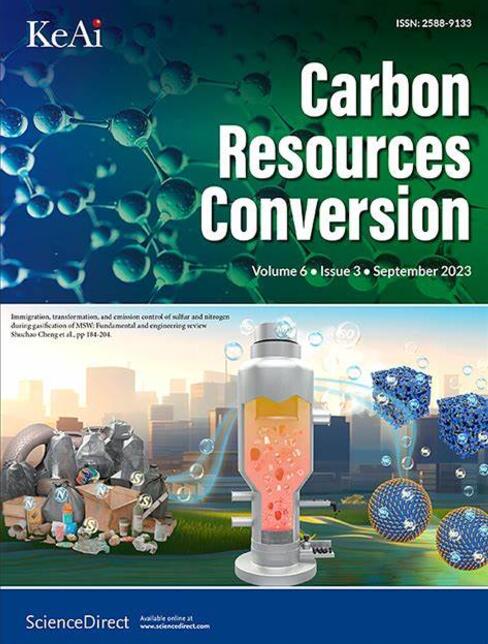乙烷在钛基催化剂上的干法重整以获得更高的选择性和转化为合成气
IF 7.5
3区 环境科学与生态学
Q2 ENERGY & FUELS
引用次数: 0
摘要
乙烷是页岩气的关键组分之一,是乙烷干重整(DRE)过程中CC键裂解制合成气(CO + H2)的重要原料。需要选择性催化剂来指导这一反应途径,以防止竞争性的CH键裂解形成乙烯。本研究采用浸渍法制备了负载在TiO2催化剂上的Fe、V、Rh氧化物。以提高对合成气(CO和H2)的选择性和减少副产物(甲烷和乙烯)的生成为主要目标,对催化剂进行了DRE测试。采用x射线衍射、扫描电镜、NH3/CO2程序升温解吸和h2 -温度程序还原对催化剂进行了表征。利用程序升温氧化法对废催化剂的焦炭含量进行了表征。在固定床反应器中,在温度500 ~ 650℃,CO2/乙烷比2:1 ~ 10:1 (mol/mol)范围内对催化剂进行了DRE反应的评价。结果表明:三种催化剂的乙烷转化率依次为Rh/TiO2 >;Fe /二氧化钛比;V /二氧化钛。Rh/TiO2催化剂表现出>;在650℃、CO2/乙烷比为5.0条件下,乙烷转化率为99%,H2和CO收率分别为36%和61%。乙烷的高转化率主要归因于Rh氧化物在TiO2载体上的分散增强以及表面酸碱位的平衡。Rh催化剂促进乙烷的CC键解离,从而形成甲基中间体,然后与吸附的CO2反应,从而在DRE反应中提高合成气产量。本文章由计算机程序翻译,如有差异,请以英文原文为准。

Dry reforming of ethane over titania-based catalysts for higher selectivity and conversion to syngas
Ethane, one of the key components of shale gas, is a valuable feedstock for the production of syngas (CO + H2) via the C![]() C bond cleavage during dry reforming of ethane (DRE) reaction. Selective catalysts are needed to direct this reaction pathway against the competing C
C bond cleavage during dry reforming of ethane (DRE) reaction. Selective catalysts are needed to direct this reaction pathway against the competing C![]() H bond cleavage for ethylene formation. In this study, Fe, V and Rh oxides supported on TiO2 catalysts were prepared by impregnation method. The catalysts were tested for DRE with the main target of enhancing selectivity to syngas (CO and H2) and reducing byproducts (methane and ethylene) formation. The catalysts were characterized using X-ray diffraction, scanning electron microscopy, NH3/CO2 temperature programmed desorption and H2-temperature programmed reduction. Temperature programmed oxidation was utilized to characterize the coke contents of the spent catalysts. The catalysts were evaluated for DRE reaction in a fixed-bed reactor at the temperature range from 500 °C to 650 °C and CO2/ethane ratio from 2:1 to 10:1 (mol/mol). It was found that ethane conversion over the three catalysts increased in the order Rh/TiO2 > Fe/TiO2 > V/TiO2. Rh/TiO2 catalyst exhibited > 99 % ethane conversion, 36 % and 61 % yields of H2 and CO, respectively, at 650 °C and CO2/ethane ratio of 5.0. The high conversion of ethane was mainly attributed to the enhanced dispersion of Rh oxides on the TiO2 support coupled with the balanced surface acidic and basic sites. The Rh catalyst facilitated C
H bond cleavage for ethylene formation. In this study, Fe, V and Rh oxides supported on TiO2 catalysts were prepared by impregnation method. The catalysts were tested for DRE with the main target of enhancing selectivity to syngas (CO and H2) and reducing byproducts (methane and ethylene) formation. The catalysts were characterized using X-ray diffraction, scanning electron microscopy, NH3/CO2 temperature programmed desorption and H2-temperature programmed reduction. Temperature programmed oxidation was utilized to characterize the coke contents of the spent catalysts. The catalysts were evaluated for DRE reaction in a fixed-bed reactor at the temperature range from 500 °C to 650 °C and CO2/ethane ratio from 2:1 to 10:1 (mol/mol). It was found that ethane conversion over the three catalysts increased in the order Rh/TiO2 > Fe/TiO2 > V/TiO2. Rh/TiO2 catalyst exhibited > 99 % ethane conversion, 36 % and 61 % yields of H2 and CO, respectively, at 650 °C and CO2/ethane ratio of 5.0. The high conversion of ethane was mainly attributed to the enhanced dispersion of Rh oxides on the TiO2 support coupled with the balanced surface acidic and basic sites. The Rh catalyst facilitated C![]() C bond dissociation of ethane thereby forming methyl intermediates which then reacted with adsorbed CO2, thereby enhancing higher syngas production during DRE reaction.
C bond dissociation of ethane thereby forming methyl intermediates which then reacted with adsorbed CO2, thereby enhancing higher syngas production during DRE reaction.
求助全文
通过发布文献求助,成功后即可免费获取论文全文。
去求助
来源期刊

Carbon Resources Conversion
Materials Science-Materials Science (miscellaneous)
CiteScore
9.90
自引率
11.70%
发文量
36
审稿时长
10 weeks
期刊介绍:
Carbon Resources Conversion (CRC) publishes fundamental studies and industrial developments regarding relevant technologies aiming for the clean, efficient, value-added, and low-carbon utilization of carbon-containing resources as fuel for energy and as feedstock for materials or chemicals from, for example, fossil fuels, biomass, syngas, CO2, hydrocarbons, and organic wastes via physical, thermal, chemical, biological, and other technical methods. CRC also publishes scientific and engineering studies on resource characterization and pretreatment, carbon material innovation and production, clean technologies related to carbon resource conversion and utilization, and various process-supporting technologies, including on-line or off-line measurement and monitoring, modeling, simulations focused on safe and efficient process operation and control, and process and equipment optimization.
 求助内容:
求助内容: 应助结果提醒方式:
应助结果提醒方式:


